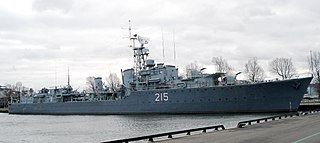
HMCS Haida is a Tribal-class destroyer that served in the Royal Canadian Navy (RCN) from 1943 to 1963, participating in World War II and the Korean War. She was named after the Haida people.
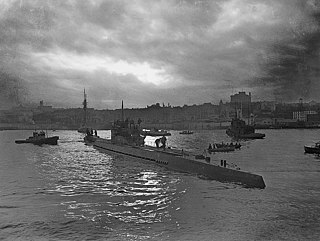
The Battle of the St. Lawrence involved marine and anti-submarine actions throughout the lower St. Lawrence River and the entire Gulf of Saint Lawrence, Strait of Belle Isle, Anticosti Island and Cabot Strait from May–October 1942, September 1943, and again in October–November 1944. During this time, German U-boats sank over 20 merchant ships and four Canadian warships. There were several near-shore actions involving the drop of German spies, or the attempted pickup of escaping prisoners of war. Despite the 23 ships lost, this battle marked a strategic victory for Canadian forces as ultimately they managed to disrupt U-boat activity, protect Canadian and Allied convoys, and intercept all attempted shore operations. This marked the first time that a foreign power had inflicted casualties in Canadian inland waters since the US incursions in the War of 1812.

HMCS Alberni was a Flower-class corvette that served in the Royal Canadian Navy (RCN) during the Second World War. The Flower-class corvettes were warships designed for anti-submarine warfare. The ship was constructed by Yarrows Ltd. in Esquimalt, British Columbia, laid down on 19 April 1940, launched on 22 August and commissioned on 4 February 1941. The corvette sailed east to join the RCN's fleet in the Atlantic via the Panama Canal, where upon arrival, the vessel began escorting trans-atlantic convoys in the Battle of the Atlantic. Alberni took part in the key convoy battle of Convoy SC 42. In 1942, the corvette was transferred to Allied convoy assignments associated with Operation Torch in the Mediterranean Sea. In 1944, Alberni was among the Canadian naval vessels assigned to Operation Neptune, the naval component of the invasion of Normandy and escorted support ships to and from the United Kingdom on D-day.

HMCS Magog was a River-class frigate that served in the Royal Canadian Navy (RCN) during the Second World War. She was used primarily as a convoy escort. On 14 October 1944, she was torpedoed by U-1223. She survived the attack, was towed to port and declared a constructive total loss. Magog was named for the town of Magog, Quebec.

HMCS New Glasgow was a River-class frigate that served in the Royal Canadian Navy during the Second World War and as a Prestonian-class frigate from 1955 to 1965. She was named for New Glasgow, Nova Scotia.

The Fairmile B motor launch was a very numerous class of motor launch produced in kit form by British boatbuilder Fairmile Marine, and then assembled and fitted out by numerous boatyards during the Second World War to meet the Royal Navy's coastal operation requirements.

Coastal Forces was a division of the Royal Navy initially established during World War I, and then again in World War II under the command of Rear-Admiral, Coastal Forces. It remained active until the last minesweepers to wear the "HM Coastal Forces" cap tally were taken out of reserve in 1968. The division received more gallantry awards than any other branch of the Royal Navy during that period.

The Coastal Forces of the Royal Canadian Navy (RCN) was a specialized naval force of well-armed, small and fast motor launch (ML) and motor torpedo boat (MTB) flotillas, primarily manned by members of the Royal Canadian Naval Volunteer Reserve (RCNVR). Tasked with escort, coastal defence, anti-submarine, minesweeping and search and rescue duties, the Coastal Forces of the RCN contributed to securing Allied sea lines of communication off the coasts of Canada and Britain during the Second World War.
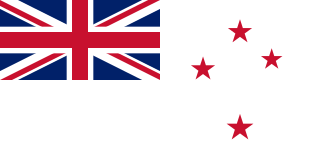
Coastal Forces was a division of the Royal Navy established during World War II. It consisted of small coastal defence craft such as motor launches, submarine chasers, air-sea rescue launches, motor gun boats and motor torpedo boats. It did not include minesweepers, naval trawlers or landing craft. This article is about the equivalent boats used in the Royal New Zealand Navy (RNZN).

HMCS Provider was a Fairmile depot ship constructed for the Royal Canadian Navy during World War II. Commissioned in December 1942, Provider served as a base ship in the Caribbean Sea, in Quebec and at Halifax, Nova Scotia. Following the war, the vessel was sold into commercial service and converted into a tanker in 1946. The ship re-entered service in 1947 and was renamed Maruba. The ship sailed under this name until 1956, when it was sold and renamed Olaya. Renamed Orgenos the same year, the tanker was acquired by the Peruvian Navy in 1960. In 1961, Orgenus was sold for scrap and broken up in Peru. The ship's registry was not deleted until 1992.

HMCS Hunter is a Canadian Forces Naval Reserve Division (NRD) located in Windsor, Ontario. Dubbed a stone frigate, HMCS Hunter is a land-based naval training establishment crewed by part-time sailors and also serves as a local recruitment centre for the Canadian Forces Naval Reserve. It is one of 24 naval reserve divisions located in major cities across Canada.

HMC ML Q050 was the first of a series of wooden Canadian-built Fairmile B motor launch (ML) boats delivered to the Royal Canadian Navy (RCN) on 18 November 1941. Originally designed for the Royal Navy by W.J. Holt of the British Admiralty and built by British boatbuilder Fairmile Marine, during the Second World War 80 Fairmile B motor launches were built in Canada for service with the Coastal Forces of the RCN.

HMC ML Q051 was a wooden Canadian-built Fairmile B motor launch (M.L.) upgunned submarine chaser delivered to the Royal Canadian Navy (RCN) on 24 November 1941. Originally designed for the Royal Navy by W.J. Holt of the British Admiralty and built by British boatbuilder Fairmile Marine, during the Second World War eighty Fairmile B motor launches were built in Canada for service with the Coastal Forces of the RCN.

HMC MLQ052 was a wooden Fairmile B motor launch (ML) upgunned submarine chaser delivered to the Royal Canadian Navy (RCN) on 31 October 1941. Originally designed for the Royal Navy by W.J. Holt of the British Admiralty and built by British boatbuilder Fairmile Marine, during the Second World War eighty Fairmile B motor launches were built in Canada for service with the Coastal Forces of the RCN.
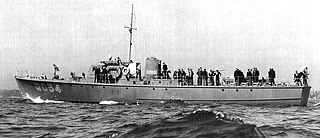
HMC ML Q054 was a wooden Canadian-built Fairmile B motor launch (ML) upgunned submarine chaser delivered to the Royal Canadian Navy (RCN) on 17 October 1941. Originally designed for the Royal Navy by W.J. Holt of the British Admiralty and built by British boatbuilder Fairmile Marine, during the Second World War eighty Fairmile B motor launches were built in Canada for service with the Coastal Forces of the RCN.

HMC ML Q055 was a wooden Canadian-built Fairmile B motor launch (ML) upgunned submarine chaser delivered to the Royal Canadian Navy (RCN) on 6 November 1941. Originally designed for the Royal Navy by W.J. Holt of the British Admiralty and built by British boatbuilder Fairmile Marine, during the Second World War eighty Fairmile B motor launches were built in Canada for service with the Coastal Forces of the RCN.

The Canadian Fairmile B was a motor launch built during the Second World War for the Royal Canadian Navy. They were adaptations of the British Fairmile B motor launch design incorporating slight modifications for Canadian climatic and operational conditions. Eighty-eight were built in Canada for service with the Coastal Forces of the Royal Canadian Navy in home waters, of which eight were supplied to the United States Navy.

HMC MLQ056 was a wooden Canadian-built Fairmile B motor launch (ML) upgunned submarine chaser delivered to the Royal Canadian Navy (RCN) on 23 November 1941. Originally designed for the Royal Navy by W.J. Holt of the British Admiralty and built by British boatbuilder Fairmile Marine, during the Second World War eighty Fairmile B motor launches were built in Canada for service with the Coastal Forces of the RCN.
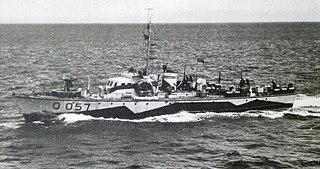
HMC MLQ057 was a wooden Canadian-built Fairmile B motor launch (ML) upgunned submarine chaser delivered to the Royal Canadian Navy (RCN) on 28 October 1941. Originally designed for the Royal Navy by W.J. Holt of the British Admiralty and built by British boatbuilder Fairmile Marine, during the Second World War eighty Fairmile B motor launches were built in Canada for service with the Coastal Forces of the RCN.

The 29th Motor Torpedo Boat Flotilla was a motor torpedo boat (MTB) flotilla manned and crewed by Royal Canadian Navy (RCN) reservists in service with the Coastal Forces of the Royal Navy during the Second World War. The 29th MTB Flotilla had a short and distinguished history in the English Channel, including action during the Normandy landings in 1944.





















